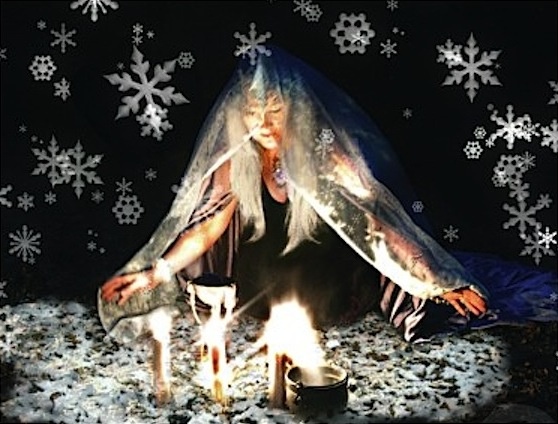——————————————
The Pagan Experience’s Monday Musing: Deity and the Divine- This will be the third week’s topic every month and an opportunity for you to share with everyone those who guide, inspire and inform you.
——————————————
In last month’s Deity and the Divine post, I mentioned being more of a naturalist Pagan and pantheist and animist who views the universe as deity. I view God, herself, as an anthropomorphized conceptualization of that which is bigger than us, and if we are gendering it, I like to give the balancing feminine in my naming of it, since the masculine has taken over for so long in our civilization. Ideally, if there wasn’t an imbalance to fix, I’d prefer balance in these biophilic traits ascribed to the divine, but I think of the divine as beyond gender, ultimately. Beyond human. Beyond living things, even, though including them. Everything that is, is God. Not just the sum of her parts, though… everything that is includes our experience, thought forms, and qualia. That’s why my concept of God includes the archetypes and cultural deities, too.
Western civilization is a little obsessed with categorization, separation, and crisp definition. Reality is a bit more blurry at the edges than that. The five human senses can only get you so far in a world and universe that wasn’t made specifically for humans, but evolved with many different kinds of beings and senses and didn’t evolve “for” anyone or anything. It just became, and is becoming what it is. We can follow along and observe with whatever senses we can evolve, and participate as the human part of the universe, of the whole. I am part of the human expression of God/dess. As are you. Thou art God.
Now for the God/dess expression of humans… it flows both ways… cultural deities are expressions of human experience and culture. Many cultures share deities that are very similar, thanks to human experience (archetypes), but each culture gives them their own name and stories, and they evolve.
I had been starting a spiritual practice that gave attention to the sun, moon, and earth, and that is ongoing, but I’ve shifted focus to an aspect of the divine that is calling to me pretty strongly. I am in the last years of raising my children, who are now teens. They are doing early enrollment in college and finishing up high school (homeschooling), so I have set aside my studies in cultural anthropology/anthropology of religion and philosophy for now to support them in their education and personal growth, and to spend all the time I can with them before they become adults and leave my home. I wanted to be here for them, to drive them to classes, to help them form good study skills, to prepare for their transition to adulthood, to make their home base a serene and orderly place, to be available for practical and emotional support, rather than busy with classes and homework, myself.
So I have a very domestic focus right now, and Hestia, Hertha, Holda, and Frigga are the archetype that I am relating with lately, even while still relating with the wilder Artemis, Arianrhod, Cerridwen, Herne, and Green Man. A hedge witch’s purview is both the hearth and the heath… the domestic and the wild… as well as the hedge between them.
I’m planning to instantiate some domestic spiritual practices like making an altar with a cauldron, flame, feathers, wool, spindle, loom, needle, spoon, and a besom, where I can tend to a relationship with Hestia (and now Holda, Hertha, and Frigga, since I’ve been doing some reading…) and veiling during ritual and housekeeping as a way to set apart those acts and enter a devotional mindset. Family, motherhood, children, home, service, community… I want to be involved fully while this part of my life’s purpose is on the front burner. I will pay attention and be available.
Reading about the Mother Holle’s disguise as Mother Goose has finally connected me with the Germanic side of my heritage, and even though I just read “Breaking the Mother Goose Code” this month, Mother Holle/Helle/Hel/Hulda means a lot to me already.
“Holda’s themes are longevity, wisdom, kinship,
magic, destiny, and karma. Her symbols are white
items and aged items. [Feathers, wool, snow, gray
hair, ash…] Among the Teutons, Holda is known as
the White Lady, an appellation that alludes to the
color of Her hair. This Goddess is the wise, ancient
crone, who has learned the lessons of destiny and
karma from a long, well-lived life and who bears the
knowledge of magic’s deeper mysteries to us with
patience and time.” ~Patricia Telesco
I was a young mother, and as I approach the end of my Motherhood stage of life, it’s comforting to know that the Crone stage can stay involved in the domestic realm and grandmothering as the stages blur at the edges. A maiden with an old soul became a young mother and will become a young crone, with plenty of time to explore domestic and wild cronehood, as it flows through transitions that will be keenly observed and participated in.


How lovely it is that you choose and are able to choose to help your children even more at this stage in their lives. Everyone recognises that small children need a lot of energy and time. But now my children are in their early teens, I find they need us even more, only in other ways. Instilling good habits etc. I hope vrouw Holle blesses your household.
What a beautiful posting! I find your desire to veil while doing housework in order to enter into a devotional mindset quite beautiful. Honouring the sacred with simple, outward signs in what can be seen as mundane work (the housework) is a way of entering into the numinous, just as surely as planned ritual is. It also honours the value of the work you’re doing.